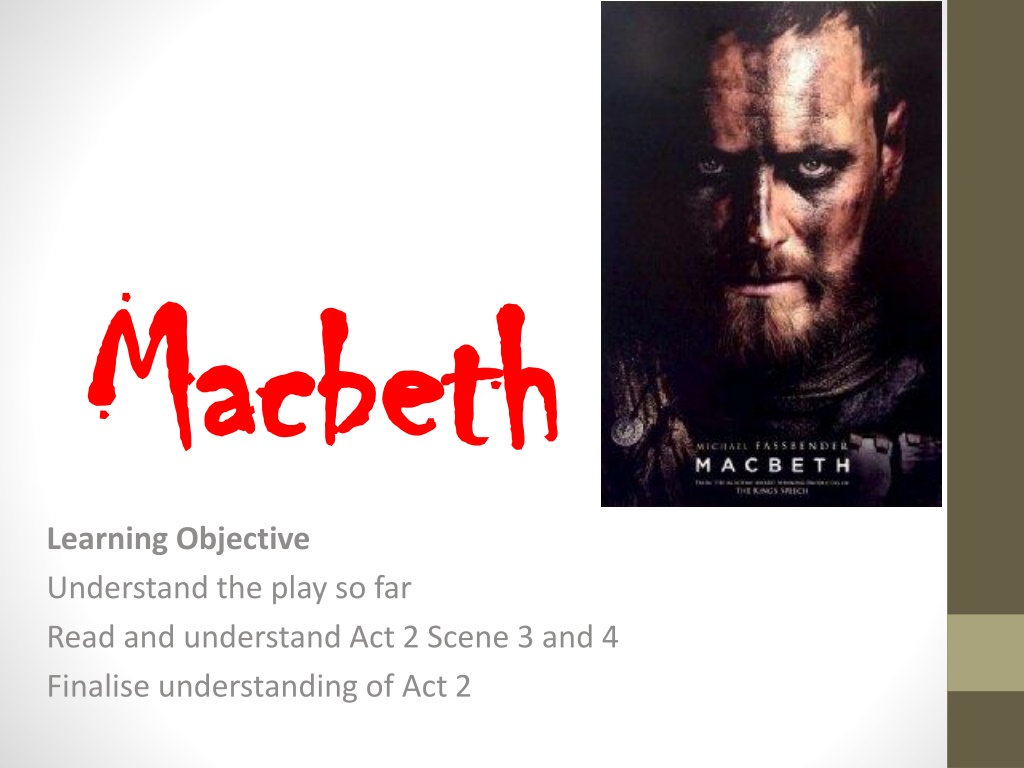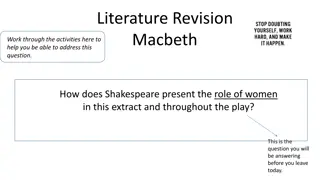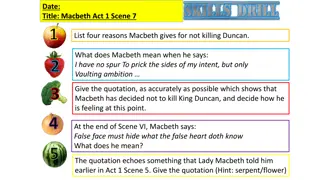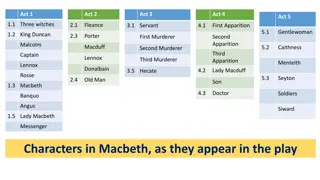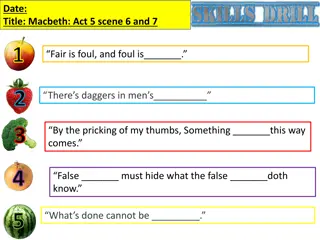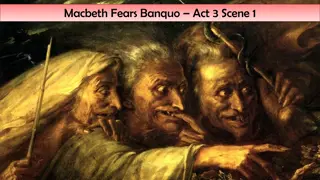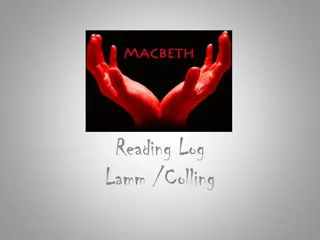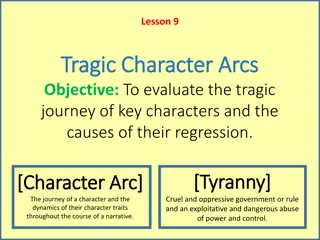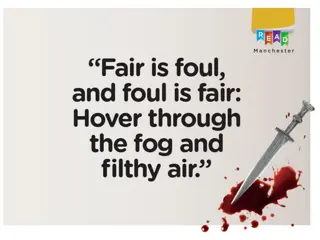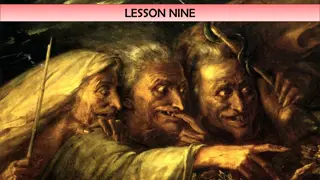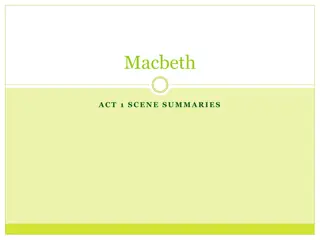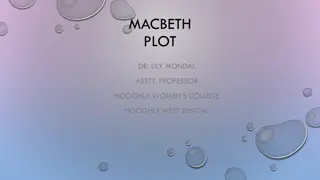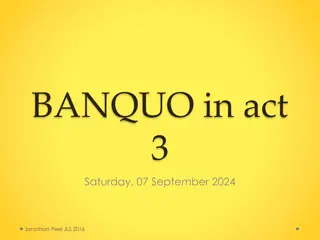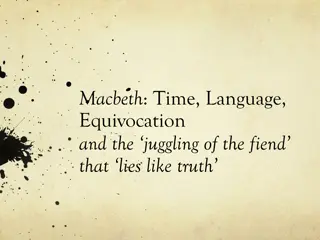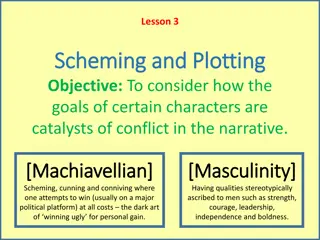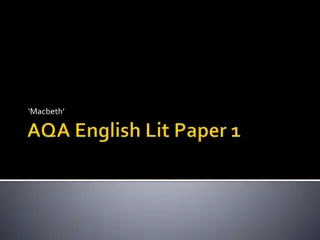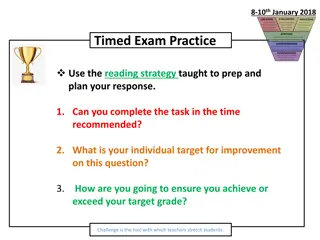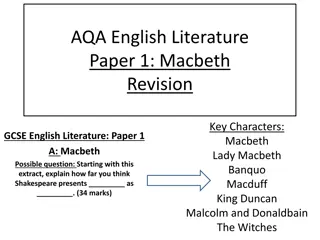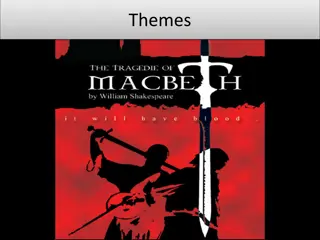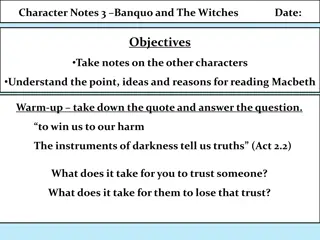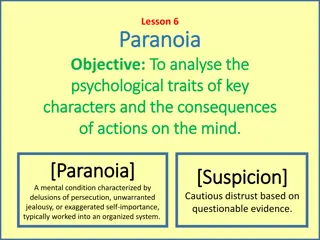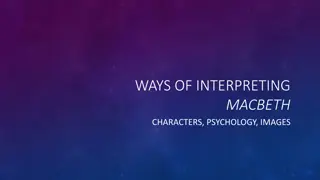Understanding Act 2 of Macbeth: Analysis and Interpretation
Explore Act 2 of Shakespeare's Macbeth through critical analysis of key scenes, character motivations, and themes such as sincerity, manipulation, and dramatic techniques. Delve into Macbeth's speeches, Lady Macbeth's reactions, and the use of stagecraft to deepen your understanding of the play's unfolding tragedy.
Uploaded on Sep 30, 2024 | 0 Views
Download Presentation

Please find below an Image/Link to download the presentation.
The content on the website is provided AS IS for your information and personal use only. It may not be sold, licensed, or shared on other websites without obtaining consent from the author. Download presentation by click this link. If you encounter any issues during the download, it is possible that the publisher has removed the file from their server.
E N D
Presentation Transcript
Macbeth Macbeth Learning Objective Understand the play so far Read and understand Act 2 Scene 3 and 4 Finalise understanding of Act 2
Starter Cut out the Simpsons events and captions on the sheet. Put them into the correct order. Extension: Can you add a quote to each event?
Reading We are going to read Act 2 Scene 3 to the end of Macbeth s second speech: Who could refrain, That had a heart to love and in that heart Courage to make s love known?
Is Macbeth sincere? Look closely at Macbeth s first speech (lines 84-9). Some believe that, in contrast with Macduff s hurried and passionate reaction to finding Duncan s body, Macbeth s words are so carefully constructed and rich in elaborate imagery that they reveal his insincerity. With a partner, talk about how you would deliver this speech and what you would try to convey to the audience about Macbeth s state of mind. Be prepared to feedback to the rest of the class.
Characters Spend some time analysing Macbeth s second, longer speech. Look at the imagery he uses, as well as the use of devices such as repetition and rhetorical questions. As with lines 84-9, Macbeth seems to have prepared this speech in advance, but behind his words he is justifying another significant murder: that of the only other witnesses to Duncan s killing. Why do you think Lady Macbeth faints at this point is she sincere? What dramatic purpose does it serve? Discuss how to stage this part of the scene. Try the lines without Lady Macbeth fainting; what difference does it make to the effect of the scene?
Reading Continue to read Act 2 Scene 3 to the end.
Reading We are going to read Act 2 Scene 4 it s short!
Stagecraft -Pathetic fallacy The shocking events taking place inside the castle seem to be mirrored by events in the wider world ( Tis unnatural / Even like the deed that s done ). This use of the pathetic fallacy and apocalyptic imagery is intended to create a great impression on the audience. Why do you think Shakespeare uses it here? How successful is it? As you read the rest of the play, consider when you see similar techniques being used.
Plenary. Looking back at Act 2 Read the following statements carefully. Which do you think is the most valid? Write down your reasons, using quotations where you can. Macbeth is a heartless killer who has murdered a kind king purely for his own benefit. Macbeth is politically clever and acts ruthlessly simply because he lives in ruthless times. Macbeth is easily manipulated by a wife he loves, and acts to prove to her that he is a rich man. Macbeth has no choice: the Witches told him what was going to happen and it was fated to be so. Macbeth is a hero who has been selected by the thanes to rescue Scotland in its hour of need. Extension: List these point in order of priority and debate your choices with each other. Can you think of any other ways to see Macbeth at this point in the play?
Homework Must: Storyboard the main events of Macbeth so far. Should: Make the storyboard bright, colourful and suitable for display. Could: Add quotes to each section of the storyboard to exemplify the main events.
